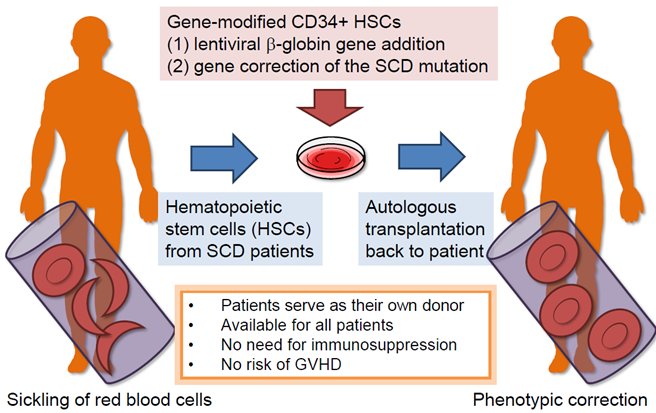Associate Professor Naoya Uchida of The Institute of Medical Science, The University of Tokyo in Japan and co-researchers at the National Heart Lung and Blood Institutes (NHLBI) / the National Institute of Diabetes and Digestive and Kidney Diseases (NIDDK), the National Institutes of Health (NIH) in the USA comprehensively discussed hematopoietic stem cell gene-addition and gene-editing therapies for sickle cell disease (SCD) and clarified the points necessary to develop a new hematopoietic stem cell therapy with genetic modification. It was published in "Cell Stem Cell" on February 4, 2021.
Abstract
Various hereditary hematopoietic diseases can be cured by genetical replacement of hematopoietic stem cells (HSCs). Patients’ own HSCs can be collected for ex vivo culture and genetically fixed by lentiviral gene addition or gene editing, followed by transplantation. Sickle cell disease (SCD) is caused by a well-defined point mutation in the β-globin gene and therefore is an optimal target for HSC gene-addition/editing therapy. In HSC gene-addition therapy, a therapeutic β-globin gene is integrated into patient HSCs via lentiviral transduction, resulting in long-term phenotypic correction. State-of-the-art gene editing technology has made it possible to repair the β-globin mutation in patient HSCs or to target genetic loci associated with reactivation of endogenous γ-globin expression. With both approaches showing signs of therapeutic efficacy in patients, we discuss current genetic treatments, challenges, and technical advances in this field.
Hematopoietic stem cell (HSC)-targeted gene-addition/editing therapy for sickle cell disease (SCD). Patients’ HSCs can be collected for ex vivo culture and genetically modified by lentiviral gene addition or gene editing, followed by transplantation.
About the research
1) Journal Article
Title:
Hematopoietic stem cell-targeted gene-addition and gene-editing
strategies for β-hemoglobinopathies
Authors Information:
Claire M. Drysdale1†, Tina Nassehi1†, Jackson Gamer1†, Morgan Yapundich1†, John F. Tisdale1*, Naoya Uchida1,2*
†Equal contributions: CMD, TN, JG, and MY. *Correspondence: JT, NU.
Affiliations:
1) Cellular and Molecular Therapeutics Branch, National Heart Lung and Blood Institutes (NHLBI) / National Institute of Diabetes and Digestive and Kidney Diseases (NIDDK), National Institutes of Health (NIH), Bethesda, Maryland (MD) 20892, USA
2) Division of Molecular and Medical Genetics, Center for Gene and Cell Therapy, The Institute of Medical Science, The University of Tokyo, Minato-ku, Tokyo 108-8639, Japan
DOI: 10.1016/j.stem.2021.01.001
URL: https://www.cell.com/cell-stem-cell/fulltext/S1934-5909(21)00001-1
Title:
Hematopoietic stem cell-targeted gene-addition and gene-editing
strategies for β-hemoglobinopathies
Authors Information:
Claire M. Drysdale1†, Tina Nassehi1†, Jackson Gamer1†, Morgan Yapundich1†, John F. Tisdale1*, Naoya Uchida1,2*
†Equal contributions: CMD, TN, JG, and MY. *Correspondence: JT, NU.
Affiliations:
1) Cellular and Molecular Therapeutics Branch, National Heart Lung and Blood Institutes (NHLBI) / National Institute of Diabetes and Digestive and Kidney Diseases (NIDDK), National Institutes of Health (NIH), Bethesda, Maryland (MD) 20892, USA
2) Division of Molecular and Medical Genetics, Center for Gene and Cell Therapy, The Institute of Medical Science, The University of Tokyo, Minato-ku, Tokyo 108-8639, Japan
DOI: 10.1016/j.stem.2021.01.001
URL: https://www.cell.com/cell-stem-cell/fulltext/S1934-5909(21)00001-1
Funding
This work was supported by the intramural research program of NHLBI and NIDDK at NIH.
Publication Journal
Cell Stem Cell
Contact
Research Contact
Associate Professor, UCHIDA Naoya
Division of Molecular and Medical Genetics, The Institute of Medical Science, The University of Tokyo (IMSUT)
https://www.ims.u-tokyo.ac.jp/imsut/jp/lab/cgct/section01.html
https://www.ims.u-tokyo.ac.jp/imsut/jp/lab/cgct/section01.html
Press Contact
Division for International Affairs office, The Institute of Medical Science, The University of Tokyo (IMSUT)
